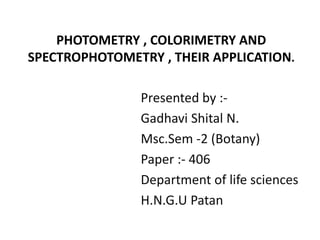
Photometry, colorimetry, spectophotometry
- 1. PHOTOMETRY , COLORIMETRY AND SPECTROPHOTOMETRY , THEIR APPLICATION. Presented by :- Gadhavi Shital N. Msc.Sem -2 (Botany) Paper :- 406 Department of life sciences H.N.G.U Patan
- 2. CONTENT Photomtery principle Principle of operation Uses of photometry Colorimetry principle Principle of operation spectrophotometry application Principle of operation Limitations Uses of colorimetry and spectrophotometry
- 3. PHOTOMETRY Principle • The word is composed of the Greek word photo- “light” and metry – “measure” • The basis of photometric working is that , the species of alkali metals and alkaline earth metals are dissociated due to the thermal energy provided by the flame source. • Due to this thermal excitation, some of the atoms are exited to a higher energy level where they are not stable. • The absorbance of light due to the electrons excitation can be measured by using the direct absorption techniques .
- 4. • The subsequent loss of energy will result in the movement of exited atoms to the low energy ground state with emission of some radiations, which can be visualized in the visible region of the spectrum. • The absorbance due to the electron excitation can be measured by using the direct absorption technique while the emititing radiation intensity is measured using the emission techniques . • The wavelength of emitted light is specific for specific elements .
- 7. Uses of photometry • Photometry is used in various industries like chemicals, soils , agriculture, pharmaceuticals, glass, and ceramics, in plant materials and water , and in biological and microbiological laboratories . • It is used in determination of potassium, sodium, magnesium and calcium in biological fluids like serum, plasma, urine etc , is routinely carried out by photometer . • Analysis of industrial water natural water for determining elements responsible for hard water is standard procedure in many laboratories.
- 8. COLORIMETRY • Colorimetry is the use of the human eye to determine the concentration of colored species. • Colorimetric methods are applicable to dilute solutions. • For a colorimetric method to be quantitative , it must from a compound with definite color characterisitics. • Color amount must be directly propotional to the concentration . • Colored compound must obey beer’s law and lambert’s law.
- 9. PRINCIPLE Beer’s Law: The amount of light absorbed by a substance in a solution is proportional to a number of absorbing molecules… i.e. concentration of the absorbing solution Log e 𝐼˳ 𝐼 =kc I=I˳𝑒−𝑘𝑐 k = constant for particular solution c = concentration
- 10. • Lambert’s law :The amount of light absorbed by a substance in a solution is proportional to the thickness of the absorbing molecules …i.e . path length Log e 𝐼˳ 𝐼 =kd I=I˳ 𝑒−𝑘𝑑 d= length of absorbing layer k = constant for particular solution
- 11. • Visual observations :- because colorimetry is based on inspection of materials with the human eye, it is necessary to review aspects of visible light. • Visible light is the narrow range of electromagnetic waves with the wavelength of 400-700 nm. • Visible light is only small portion of the electromagnetic spectrum.
- 12. COLORIMETER
- 14. SPETROPHOTOMETRY Applications Qualitative analysis : used to identify classes of compound in both pure state and in biological preparations. This is based on the fact that absorption spectra are specific for a class of compound. Denatration of double standard DNA : DNA absorbed at 260 nm. This absorbance increase with rise in temperature , as double standard DNA become single stranded.
- 15. Continues…. • Enzyme assay and kinetic studies : the quantitative assay of enzyme activity is carried out when substrate or product is colored absorbs light in UV range. • Molecular weight determination : the molecular weight of amines , , sugars and many aldehyde and ketone compounds can be determined .
- 16. Continues….. • Control purity : impurity in compound can be detected easily spectrometric studies • 1, carbon disulfide impurity in carbon tetrachloride can be detected easily by measuring absorbance at 318 nm where only carbon disulfide absorb. • Protein folding: protein or protein– nucleic acid interaction can be studies
- 18. INSTRUMENTATION Basic component : • Light sources • Monochromatic and filter • Sample holder • Photo detector
- 20. Limitation • Applicable for monochromatic light. • Applicable lower concentration. • Applicable only clear solution.
- 21. • Colorimetry and spectophotometry are of prime importance in biochemical research . If the absorbancy index at a specific wavelength is known, the concentration of a compound can be readily determind by measuring optical density at that wavelength . As the value of absorbancy index is very large in nucleotides, very small quantities of the absorbing material can be accurately measured. The course of a reaction can be determind by measuring the rate of formation or disappearance of a light absorbing substance .thus NADH absorbs strongly at 340 nm– whereas the oxidised form NAD—has no absorption at this wavelength . Therefore, reactions involving the production or utilisation of NADP can be assayed by the technique .
- 22. Compound can be frequently identified by determining the characteristic absorption spectra in the ultraviolet and visible region of the spectrum.
- 23. REFERENCE: • Biochemistry C. B. Power G. R . Chatwal
- 24. THANK YOU …